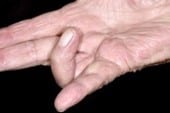Treatment
You cannot prevent progression of the disease. There is no evidence that stretching the affected finger or wearing a splint will help. Sometimes the nodules in the palm may be painful but this usually settles over time. You may wish to avoid heavier tasks that aggravate the site of the nodules to see if that helps relieve the pain.
You should continue to use your hand as normally as possible. Speak to your healthcare practitioner if your finger starts to cause problems with your everyday function, or if the smaller joints in your fingers are affected.
Pain relief
Medication (such as simple painkillers or anti-inflammatories) may be useful. A pharmacist or your healthcare practitioner can help advise you what to take if needed. You can find further information here on what medications you could take here:
How and when to take paracetamol for adults – NHS (www.nhs.uk)
Ibuprofen for adults: painkiller which also treats inflammation – NHS (www.nhs.uk)
Ice or heat therapy
You may find heat helpful to ease stiff and painful joints. Try filling a bowl with warm water or resting your hand on a microwaved heat pack for 10 minutes. Do not use heat if your joint is hot and swollen as it may make it worse. Instead you can consider using an ice pack or bag of frozen peas.
Place a tea towel on your wrist (to protect your skin from ice burns), and then place an ice pack or bag of frozen peas over the painful area. Leave this on for ten minutes and use up to 3 times per day.
- Please be cautious using ice if you have altered sensation or circulatory problems.
- Check the skin regularly, and stop if there is excessive pain or tingling.
Hand Exercises
General movement of the hand can be beneficial to improve/maintain range of movement and prevent stiffness.
